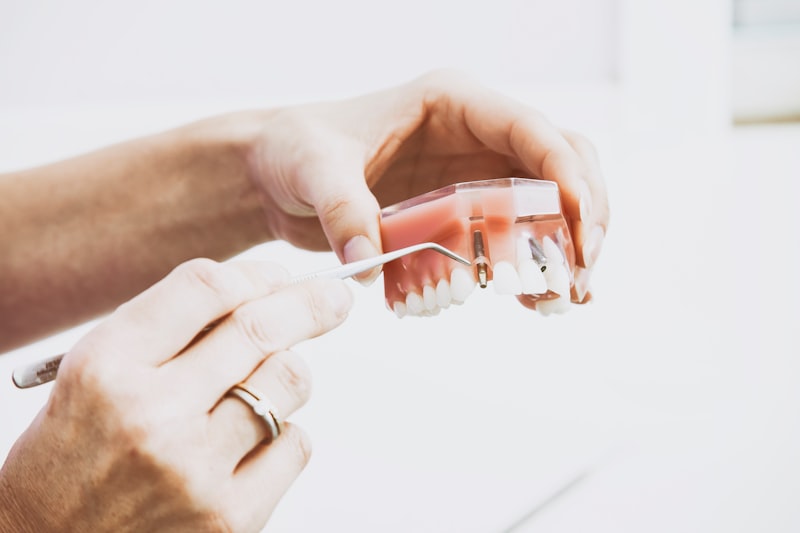-
Bristle Type: Toothbrushes come with different types of bristles: soft, medium, and hard. Dentists generally recommend using a soft-bristled brush because it’s gentle on your gums and enamel while effectively cleaning your teeth. Medium and hard bristles can be too abrasive, potentially causing gum recession and enamel erosion over time.
-
Size of the Head: The size of the toothbrush head matters, especially if you have a smaller mouth or need to reach difficult areas like wisdom teeth or the back molars. A smaller head allows for better maneuverability and access to all parts of your mouth, ensuring a thorough clean.
-
Handle Grip: Consider the handle grip of the toothbrush. It should feel comfortable and secure in your hand. Some toothbrushes have ergonomic handles with grips or flexible necks, which can make brushing easier and more effective, especially for those with arthritis or limited dexterity.

Manual vs. Electric: The choice between a manual and an electric toothbrush depends on your preference and dental needs. Electric toothbrushes can be more effective in plaque removal due to their oscillating or rotating heads, making them a good option for people with orthodontic appliances or those who have trouble brushing manually.
-
ADA Seal of Approval: Look for toothbrushes that have earned the American Dental Association (ADA) Seal of Approval. This ensures the toothbrush has undergone rigorous testing for safety and efficacy. Products with this seal meet ADA criteria for effectiveness in plaque removal and safety for use in the mouth.
-
Replace Regularly: Regardless of the type of toothbrush you choose, it’s crucial to replace it regularly. Dentists recommend getting a new toothbrush or replacing the head of an electric toothbrush every 3 to 4 months, or sooner if the bristles become frayed.
Choosing the right toothbrush is essential for maintaining good oral hygiene. By selecting one that fits comfortably in your hand, has soft bristles, and meets your specific dental needs, you can ensure effective cleaning and protection for your teeth and gums. Ready to upgrade your brushing routine? Start by finding the perfect toothbrush today!
Deciphering Dental Care: Mastering the Art of Choosing Your Perfect Toothbrush
Choosing the right toothbrush might seem like a mundane task, but it plays a crucial role in your oral hygiene routine. With so many options available on the market today, from manual to electric, soft bristles to medium, it can be overwhelming to decide which one suits you best. Here’s a guide to help you navigate through the sea of toothbrushes and find your perfect match.
Firstly, consider the type of toothbrush: manual or electric. Manual toothbrushes are straightforward and come in various shapes and sizes, catering to different preferences. They require proper brushing techniques for effective cleaning. On the other hand, electric toothbrushes offer automated brushing motions, making them easier to use, especially for those with limited dexterity. They often come with features like timers and pressure sensors to enhance your brushing experience.
Next, focus on the bristles. Toothbrush bristles come in different textures, primarily soft, medium, and hard. Dentists generally recommend soft bristles as they are gentle on gums and tooth enamel while effectively removing plaque and debris. Medium and hard bristles, although effective at cleaning, can potentially cause gum recession and enamel erosion if not used properly.
Size and shape matter too. A toothbrush head should comfortably fit into your mouth and reach all surfaces of your teeth. Smaller heads are often preferred as they can maneuver better around tight spaces, such as molars, ensuring thorough cleaning. Choose a handle that feels comfortable in your hand, allowing for a firm grip and easy maneuverability during brushing.
When selecting a toothbrush, think about your specific dental needs. For example, individuals with sensitive teeth or gum recession might benefit from extra soft bristles and gentle brushing techniques. Those with braces or dental appliances might find orthodontic toothbrushes or electric models with specialized brush heads more effective.
Ultimately, the perfect toothbrush is one that encourages you to brush regularly and effectively. Whether you opt for a manual toothbrush with soft bristles or invest in a high-tech electric model, the key lies in consistent and proper brushing techniques. Experiment with different types until you find the one that leaves your mouth feeling clean, fresh, and healthy after every use.
From Soft to Hard: Selecting the Ultimate Toothbrush for Optimal Oral Health
Let’s start with the basics. Soft-bristled toothbrushes are ideal for those with sensitive gums. They offer a gentle touch that cleans without irritating, making them perfect for daily brushing. Imagine a soft breeze on a summer day, comforting and nurturing — that’s what soft bristles do for your gums.
On the other end of the spectrum, we have toothbrushes with harder bristles. These are designed for individuals who require a more robust cleaning action, effectively removing plaque and debris with each stroke. Think of it as a reliable scrubber tackling tough stains, ensuring your teeth sparkle with cleanliness.
Now, the key lies in matching the toothbrush to your specific dental needs. If you have sensitive gums or dental work like crowns or veneers, a soft-bristled brush offers gentle care without compromising effectiveness. It’s like finding the perfect balance between strength and tenderness, ensuring your oral health routine remains soothing yet thorough.

Conversely, if you prioritize a deep clean and have no issues with gum sensitivity, a toothbrush with harder bristles might be your go-to. It’s akin to having a dependable ally in your corner, ready to tackle any dental challenge head-on, leaving your teeth feeling polished and refreshed.
Ultimately, the choice between soft and hard bristles boils down to personal preference and dental needs. Whether you opt for the comforting touch of soft bristles or the vigorous clean of harder ones, what matters most is consistency in your oral care routine. So, next time you’re browsing the dental care aisle, remember: your toothbrush isn’t just a tool; it’s your partner in achieving optimal oral health.
Brushing Up: A Step-by-Step Guide to Picking Your Ideal Toothbrush
Choosing the right toothbrush might seem like a mundane task, but it plays a crucial role in maintaining good oral hygiene. With so many options available in the market today, finding your perfect match can be overwhelming. Fear not! Let’s break down the essentials so you can brush up on how to select the ideal toothbrush for your needs.
Firstly, consider the bristles. Soft, medium, or hard? Dentists often recommend soft bristles as they are gentle on gums and effectively remove plaque from teeth surfaces without causing damage. Medium and hard bristles can be too abrasive for most people and may lead to gum recession over time.
Next, think about the size and shape of the brush head. A smaller head allows for better access to all areas of your mouth, including those tricky molars and the back of your tongue. It ensures that every tooth gets the attention it deserves, making your brushing more effective overall.
Handle comfort matters too. Look for a toothbrush with a non-slip grip that feels comfortable in your hand. This makes it easier to maneuver the brush and reach all areas of your mouth without slipping or causing discomfort during longer brushing sessions.
Electric or manual? This boils down to personal preference. Electric toothbrushes can be more efficient in removing plaque and reducing gingivitis if used correctly. They often come with built-in timers and various brushing modes, which can be beneficial for those with limited dexterity or who prefer a bit of extra help in their oral care routine.
Lastly, don’t forget about durability and quality. Investing in a good toothbrush pays off in the long run. Replace your toothbrush or brush head every 3 to 4 months or sooner if the bristles fray. This ensures optimal performance and hygiene benefits from your toothbrush.
By considering these factors—bristles, size, handle comfort, type, and durability—you can confidently choose the ideal toothbrush that suits your oral health needs. Happy brushing!
The Toothbrush Dilemma: Which Bristle Type Fits Your Dental Routine?
Soft bristles are gentle on your gums and tooth enamel, making them ideal for those with sensitive teeth or gums prone to bleeding. They effectively remove plaque and food particles without causing irritation, ensuring a comfortable brushing experience. If you’re someone who brushes diligently but has concerns about gum recession or enamel wear, a soft-bristled toothbrush might be your perfect match.
On the other hand, medium bristles offer a balance between cleaning power and gentleness. They can effectively remove plaque and surface stains without being too harsh on your gums. If you have relatively healthy gums and teeth, and you prefer a bit more thorough cleaning, a medium-bristled toothbrush could be just what you need.
For those seeking a more vigorous cleaning action, hard bristles might seem tempting. However, it’s essential to tread carefully here. Hard bristles can be abrasive and potentially damage your gums and tooth enamel if not used correctly. Dentists often recommend hard bristles only for specific situations, such as removing tough stains or plaque buildup under professional guidance.
When selecting your toothbrush, consider your unique dental needs and preferences. Do you have sensitive gums or teeth? Are you looking for a gentle clean or a more robust brushing experience? Asking yourself these questions can guide you towards the bristle type that best suits your dental routine.
Remember, regardless of the bristle type you choose, proper brushing technique is key to maintaining good oral health. Brush gently in circular motions, ensuring you cover all tooth surfaces and gum lines. Pair your brushing routine with regular flossing and dental check-ups for a smile that’s both healthy and radiant.
Ergonomic Excellence: Finding Comfort in Your Toothbrush Selection
Imagine starting your day with a toothbrush that fits perfectly in your hand, its handle designed to ergonomically support your grip. This simple yet crucial feature can make a significant difference in how you approach your oral care regimen. With a comfortable grip, brushing becomes less of a chore and more of a pleasant ritual.
Beyond the handle, ergonomic toothbrushes often feature innovative designs that cater to different needs. Whether you prefer a soft bristle for gentle cleaning or a firmer one for a thorough scrub, ergonomic toothbrushes come in various options to suit your preferences. Some even incorporate flexible necks that adjust to the contours of your mouth, ensuring every corner is reached effortlessly.
The impact of ergonomic excellence extends beyond convenience. It promotes healthier brushing habits by encouraging proper technique and reducing the risk of strain or discomfort. By aligning the toothbrush design with human ergonomics, manufacturers aim to enhance the user experience, making oral care not only effective but also enjoyable.
Next time you shop for a toothbrush, consider the ergonomic factors. Pay attention to how it feels in your hand and how well it adapts to your brushing style. Investing in ergonomic excellence means investing in your comfort and oral health, ensuring that each brush brings you one step closer to a brighter, healthier smile.
Beyond Bristles: Exploring Toothbrush Features That Make a Difference
When it comes to oral hygiene, the humble toothbrush is your everyday hero. But did you know that modern toothbrushes are more than just bristles? They’re packed with features designed to elevate your dental care routine to the next level.
One of the standout features is sonic technology. Imagine your toothbrush wielding the power of sound waves, creating gentle yet effective vibrations that reach deep between your teeth and along the gumline. It’s like a mini spa treatment for your mouth, ensuring a thorough clean every time.
Then there’s the smart timer feature, a game-changer for those prone to rushing through their brushing routine. This handy addition ensures you spend the dentist-recommended two minutes brushing, evenly divided between all sections of your mouth. No more guesswork, just precise cleaning.
For those concerned about gum health, pressure sensors offer peace of mind. These sensors detect if you’re applying too much force while brushing, helping prevent gum recession and enamel wear. It’s like having a personal dental coach right in your hand, guiding you towards optimal brushing technique.
And let’s not forget about UV sanitizers, a boon for the hygiene-conscious. After use, simply pop your brush head into the sanitizer, where ultraviolet light works its magic by eliminating bacteria and germs. It’s the extra step that ensures your brush stays as clean as your smile.
Innovation doesn’t stop there. Some toothbrushes even come with multiple brushing modes—like daily clean, sensitive, and gum care—allowing you to tailor your brushing experience to your specific oral health needs.
With these advanced features, today’s toothbrushes are more than tools—they’re partners in your quest for a healthier smile. From sonic vibrations to smart timers and UV sanitizers, each feature is designed to make a tangible difference in your oral care routine, ensuring you achieve that fresh-from-the-dentist clean every day. So, why settle for basic bristles when you can brush with innovation?
Frequently Asked Questions
How do I know if a toothbrush is ADA-approved?
Learn how to determine if a toothbrush is ADA-approved with our concise guide. Discover key indicators and what to look for on the packaging to ensure your toothbrush meets the American Dental Association’s standards for safety and effectiveness.
What are the benefits of using a soft-bristled toothbrush?
Discover the benefits of using a soft-bristled toothbrush. Learn how gentle bristles help prevent gum damage, reduce enamel wear, and effectively clean sensitive teeth and gums. Find out why dental professionals recommend soft-bristled brushes for optimal oral hygiene.
How often should I replace my toothbrush?
Learn when to replace your toothbrush for optimal oral hygiene. Follow our guidelines to ensure your toothbrush remains effective and clean.
Should I choose a manual or electric toothbrush?
Choosing between a manual or electric toothbrush depends on personal preference and specific dental needs. Manual brushes offer simplicity and are budget-friendly, while electric brushes can provide more effective plaque removal and are easier to use for those with limited dexterity. Consult with your dentist to determine which type best suits your oral health goals.
What are the key factors to consider when choosing a toothbrush?
When choosing a toothbrush, consider factors like bristle softness (soft, medium, or hard), head size (suitable for comfortable reach), handle grip (comfortable to hold), and ADA approval (ensures safety and effectiveness). These factors help ensure effective cleaning without causing damage to gums or enamel.


